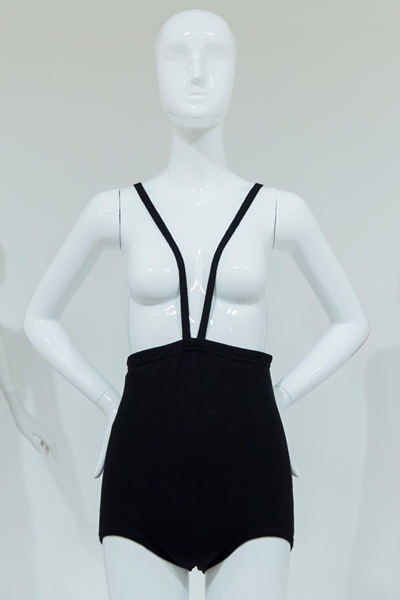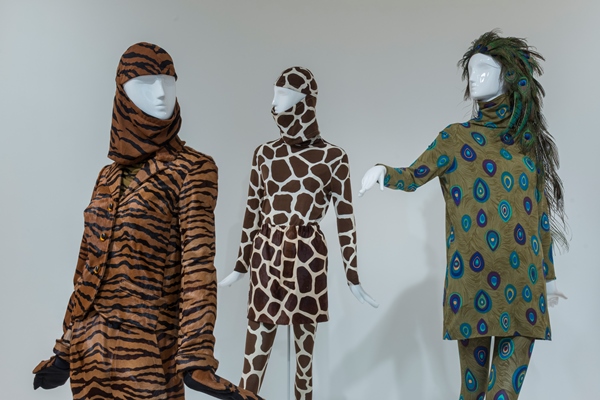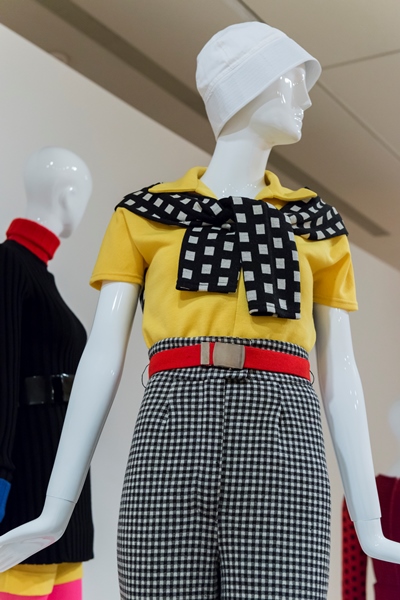
Rudi Gernreich (1922–1985), Monokini, 1964, wool, Harmon Knitwear, Inc., manufacturer (20th c.). Collection of Peggy Moffitt
The title of the Cincinnati Art Museum exhibition featuring the apparel designs of Rudi Gernreich – notorious for his topless swimsuit — is inspired. “The Total Look” defines the Austrian-born designer’s aesthetic concept that every element of an ensemble should complement every other. He designed everything from head to toe – hats to shoes – and from the inside out – lingerie to outerwear.

Rudi Gernreich (1922–1985), Tiger Ensemble: Jacket, Dress, Skirt, Hat, Gloves, Tights, Bra, Panties, and Shoes, 1966, stenciled calfskin, nylon, plastic, and leather. Collection of Peggy Moffitt
Rudi Gernreich (1922–1985), Giraffe Ensemble: Dress, Skirt, Hat, Tights, Bra, Panties, and Shoes, 1966, stenciled calfskin, nylon, and leather. Collection of Peggy Moffitt
Rudi Gernreich (1922–1985), Peacock Dress and Tights, 1966, nylon. Collection of Peggy Moffitt
But “The Total Look” also refers to the collaboration with his muse, the model Peggy Moffitt, and with her photographer husband, William Claxton. When Moffitt in her exaggerated makeup, which she devised, cavorted in front of Claxton’s lens, she animated and, in a sense, completed Gernreich’s designs.

William Claxton (1927-2008), Peggy Moffitt in Rudi Gernreich Mini-dress with Flower Earring, 1967, digital print, 24” x 20”. ©William Claxton, LLC, courtesy of Demont Photo Management, with permission of the Rudi Gernreich trademark.
“Without Rudi I would have been a gifted and innovative model,” explained Moffitt in The Rudi Gernreich Book. “Without me he would have been an avant-garde designer of genius. We made each other better. We were each other’s catalyst. . . . It was fun, it was invigorating, it was a true collaboration, and yes, it was love.”1
Gernreich was born in Vienna on August 8, 1922. His father was a hosiery manufacturer who committed suicide when his son was eight. Gernreich learned about women’s fashion in his Aunt Hedwig Mueller’s dress shop, and by the time he was 12, he had impressed the Austrian designer Ladislaus Zettel so much with his fashion sketches that he asked Gernreich to accompany him to London as an apprentice. But his mother felt he was too young to go. Four years later, in 1938, he and his mother fled Europe, and, as Jewish refugees, emigrated to Los Angeles where he lived until his death of lung cancer in 1985.

William Claxton (1927-2008), Peggy Moffitt in Rudi Gernreich Roualt (sic) Swimsuit, 1971, digital print, 24” x 20”, ©William Claxton, LLC, courtesy of Demont Photo Management, with permission of the Rudi Gernreich trademark.
Gernreich’s career began in the early ’50s with unstructured knit swimsuits. Although American sportswear pioneer Claire McCardell had produced suits with no internal structure in the 1940s, the prevailing style of the next decade had enough underpinning to be “seagoing corsets” as a Sports Illustrated article described them.
It would be Gernreich’s 1964 monokini – topless – swimsuit that cemented his reputation in pop culture. He had predicted, “Bosoms will be uncovered within five years” in a September 1962 issue of Women’s Wear Daily. At the end of 1963, Look magazine editor Susanne Kirkland, who was doing a futuristic trend story, dared Gernreich to do it.
Gernreich never intended the monokini to be manufactured. Moffitt explains, “Rudi did the suit as a social statement. It was an exaggeration that had to do with setting women free. It had nothing to do with display, and the minute someone wears it to show off her body, you’ve negated the entire principle of the thing.”2
But when Diana Vreeland of Vogue saw the suit, she insisted it had to be produced. After getting orders from buyers all over the country, Harmon Knitwear put it into production; 3,000 were eventually sold at $20. But the suit was condemned by everyone one from the Pope to the mayor of Saint-Tropez who used helicopters to patrol the beaches.3
“Fashion forward” is a term casually thrown around but Gernreich truly was fashion forward. His 1963 oversized herringbone tweed coat anticipated Nina Ricci’s by months. In 1958 his trapeze silhouette predated Yves St. Laurent’s by three years, and his 1964 lacquered chiffon see-through blouse appeared four years earlier than the French designer’s.
Gernreich had a major impact on women’s underpinnings. Although he preferred his clothing to be worn braless, he designed a simple brassiere called the No Bra. It did away with the stiffness that had turned women’s breasts into torpedoes. He introduced the thong in 1974, intending it to be the only thing worn under his black jersey evening gowns, mere columns of soft fabric that featured the aluminum “sculptures” by Christian Van Blaker. Gernreich translated men’s briefs and boxers into women’s lingerie seven years before Calvin Klein introduced his versions in 1983.
Gernreich was always a “proponent for reasonably priced clothes and was anti-‘status’ fashion” according to Moffitt.4 He designed a collection for Montgomery Ward in 1966, anticipating Target’s collaborations with top designers four decades later.
Although Gernreich’s designs fall into the vintage category today and do define an era, they still look fresh and wearable. Please, please give me his 1964 Marlene Dietrich Suit in white lingerie satin, a novel use of the fabric. Gernreich’s appropriation of men’s fashion was intended to set women free. In a January 1, 1970, issue of Life, he envisioned a time when styles would be unisex with women in trousers and men in skirts.5

Rudi Gernreich, Baby Doll Dress, Belt, and Earrings, 1965, silk and paper composition. Collection of Peggy Moffitt
What Gernreich showed on the runway made it into the mainstream because he had made eminently wearable clothes.6 My bridesmaids wore longer versions of Gernreich’s 1965 baby doll dresses five years later. And about 1972 I made a knit tunic with matching trousers quite like his 1968 poison green Ensemble: Sweater, Pants, and Wig/Hat with matching shoes. Moffitt posed, sitting in a lotus position, leaning over with her elbows bent nearly touching the floor. Her cheeks rest on her hands with the fingers folded over, a soft fist. With her mop-top, ruffled collar and cuffs, and exaggerated makeup, she made a colorful Pierrot. My version was a more conservative beige and the ruffles were gone, but I did wear it with a curly wig.
One of Gernreich’s signatures was his use of heretofore clashing colors: pink and orange, blue and green, red and purple. Fashion writer Marylou Luther described him as “rearranging the rainbow with shocking combinations.”And Gernreich had no qualms about mixing patterns, breaking one of my mother’s fashion rules. Instead he reveled in pitting pattern against pattern: checks, dots, stripes, gardens-full of florals.7

Rudi Gernreich, Chinese Opera Minidress, Apron, and Earrings, 1967, silk, ceramic, and metal. Collection of Peggy Moffitt.

William Claxton (1927-2008), Peggy Moffitt in Rudi Gernreich from the Siamese Collection, 1968, digital print, 24” x 20”, ©William Claxton, LLC, courtesy of Demont Photo Management, with permission of the Rudi Gernreich trademark.

William Claxton (1927-2008), Peggy Moffitt in Rudi Gernreich Blouse and Hat from the Siamese Collection (detail), 1968, digital print, 24” x 20”, ©William Claxton, LLC, courtesy of Demont Photo Management, with permission of the Rudi Gernreich trademark.
Gernreich’s designs of the 1970s (his last collection was done in 1981) were criticized for their lack of daring. By then he saw “fashion going out of fashion,” and he wanted to create “uniforms,” functional knit tops and bottoms that would take on the personality of the wearer. He would ask buyers if they could see a Gernreich signature in the designs. If they said yes, he felt that he had failed. He wanted his clothes to be anonymous.8

Rudi Gernreich, Trompe l’oeil Ensemble: Overblouse, Blouse, Pants, and Belt, 1973, wool, leather, and metal. Harmon Knitwear, Inc., manufacturer (20th c.) Collection of Peggy Moffitt.
Gernreich succeeded in many areas, but anonymity was not one of them. His characteristic wit is still at play in his 1973 trompe l’oeil blouse that spoofed Halston’s affected look of tying a sweater around your shoulders.
In The Rudi Gernreich Book, Moffitt lovingly lists all of the designer’s firsts: to combine bold, clashing color; used fabrics in unexpected ways, including vinyl and plastic; first coordinated tights with ensembles; knitted tube dresses; designer jeans. Moffitt goes on and on.9
But Gernreich also saw himself as half-designer, half-social commentator, seeing his clothes as sociological statements.10
Fashion writer Marylou Luther summed up his contributions beyond fashion:
Through his designs, Gernreich said a lot of things that were not confined to fashion: that women’s bodies deserve to be free of the constraints that have kept them submissive to men; that women’s clothes and men’s clothes could be interchangeable, thus making the two sexes truly equal; that utilitarian uniforms could take our minds off how we look so we could concentrate on how we act; that fashion isn’t tragedy – it’s entertainment; that nudity is no loner equated with morality that how we dress is inextricably linked to how we live; that wit and humor will always have the last laugh on the superserious (sic), sometimes supercilious world of fashion.11
Karen S. Chambers
“The Total Look: Rudi Gernreich, Peggy Moffitt, and William Claxton” was organized by Cameron Silver, fashion historian and founder of the high-end vintage clothing store in Melrose, CA. The exhibition draws primarily on Moffitt’s personal collection and is supplemented here with eight pieces from the Cincinnati Art Museum’s collection. In addition, there are photographs of Vidal Sassoon who revolutionized women’s hairstyles and who might be considered the fourth collaborator with Gernreich. Instead of the heavily lacquered helmet-like styles of the ’50s and ‘60s, his short geometric haircuts were “wash-and-wear.” Near the end of his life, he spent time in Cincinnati because of a licensing arrangement with Procter & Gamble. The exhibition has also been seen at Los Angeles Museum of Contemporary Art’s Pacific Design Center and the Savannah College of Art and Design.
FOOTNOTES
1Peggy Moffitt in Peggy Moffitt and William Claxton, essay (“Looking Back at a Futurist”) by Marylou Luther, The Rudi Gernreich Book, 1991, Taschen, p. 316.
2 Peggy Moffitt, 1985 statement.
3 At least two suits were worn in public. Carol Doda, a 39” x 26” x 36” entertainer, wore it in her act at the Condor Club in San Francisco. Nineteen-year-old Toni Lee Shelley was arrested in Chicago for “suspicion of improper attire for bathing.” Moffitt and Claxton, p. 21.
4 Ibid., p. 5.
5 Ibid., p. 31.
6 “In every collection there were always beautiful, easy-to-wear clothes. These weren’t generally photographed because they weren’t news. They were never dowdy or boring and could be worn by people who didn’t look like fashion models.” Peggy Moffitt. Ibid., p. 284.
7 Ibid., p. 16.
8 Ibid., p. 34.
9 Ibid., p. 5.
10 Ibid., p. 6.
11 Ibid., p. 7.
“The Total Look: Rudi Gernreich, Peggy Moffitt, and William Claxton” through May 24, 2015. Cincinnati Art Museum, 953 Eden Park Drive, Cincinnati, OH 45202. Tues.-Sun., 11 a.m. to 5 p.m. (513) 639-2995, www.cincinnatiartmuseum.org.



